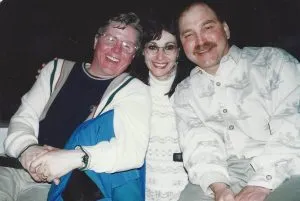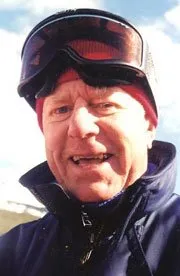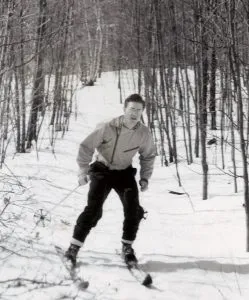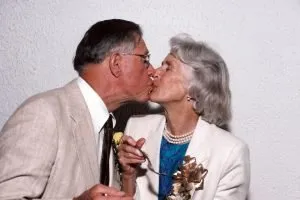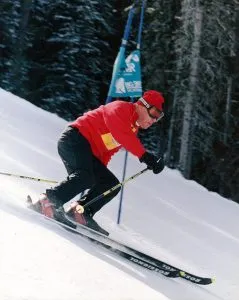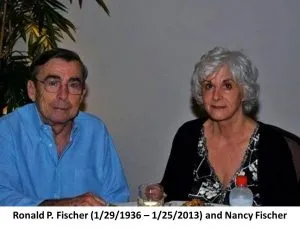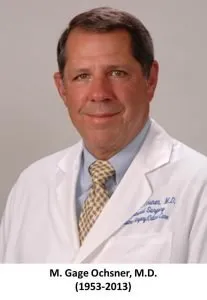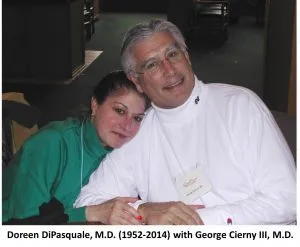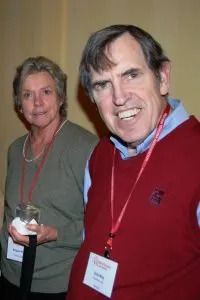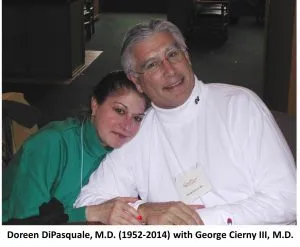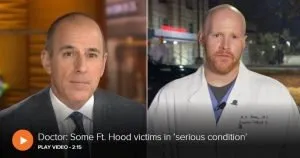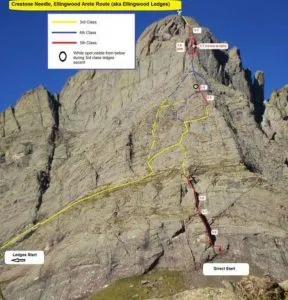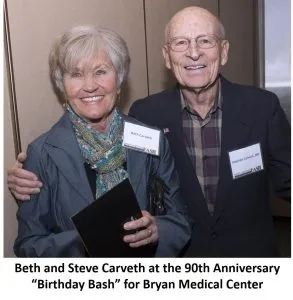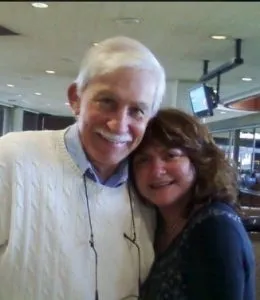In Memorium
In Memorium
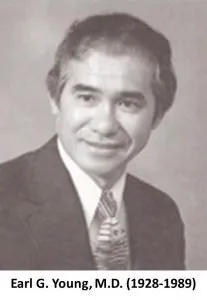
Dr. Young received his medical degree from the University of Rochester, N.Y. and Ph.D. in surgery from the University of Minnesota. He completed advanced training in cancer research at Harvard, a fellowship in cardiovascular surgery at Baylor University in Houston and studied microvascular surgery at the University of California–San Diego.
He was a clinical professor of surgery at the University of Minnesota Medical School, and a practicing general and vascular surgeon at the Park-Nicollet Clinic in Minneapolis from 1960. He was nationally known and was actively involved in research and education throughout his career. In 1988, one year before his untimely death, he received the Owen H. Wangensteen Award for Academic Excellence from the University of Minnesota Health Science Center. It was awarded by an unprecedented unanimous vote of all 72 surgical residents.
– Dr. John Najarian characterizing Earl at a memorial service in his honor at the University of Minnesota.
Dr. Gerry Gussack was an otolaryngologist and member of the Western Trauma Association who was a beloved friend to all that knew him. His early death at the age of 43 shocked the entire membership. He was only the second WTA member since Dr. Earl Young to pass away since the founding of our association.
During the WTA meeting sessions and events, Gerry was always around with his camera, taking pictures of of the members and, most importantly, members with their families. Gerry epitimized the family spirit of the WTA: to him, the WTA was family.
Our record-keeping during the early years of the association were not very thorough or meticulous, so we do not yet know when Gerry became a member of the WTA. Nevertheless, when we decided that we needed to establish a position of Historian within the group, Gerry was our natural choice. His camera skills continued to capture our relaxed and convivial moments.
Gerry was highly regarded in his field. In 1996, a year prior to his passing, the Georgia Society of Otolaryngology/Heand and Neck Surgery awarded him the first Gussack Award, so named in his honor. After Gerry’s death, his alma mater, Tulane, established the The Gerald S. Gussack ’75 M.D. Award, to the most outstanding graduating senior in Cell and Molecular Biology: “The recipient is chosen based on excellence in Grade Point Average, creativity in honors thesis research, and a demonstration of well balanced academic achievement. The award is named in honor of the late Gerald Gussack, a Professor of Otolaryngology at Emory University School of Medicine, who was a 1975 graduate of Tulane College”
It seemed all too soon after that when we learned that he’d contracted a brain tumor. He carried on with his wonderful personality and good spirits in the subsequent WTA meetings he attended. We were all saddened with his passing, knowing we’d lost a true friend.
Representing the membership, WTA President Jerry Jurkovich attended Gerry’s funeral in Georgia.
The Emory Medicine Class Notes from 1998 reported the following upon his death:
“Gerald S. Gussack, professor and former interim director of the division of otolaryngology, on Aug. 26, 1997, of a brain tumor.
Dr. Gussack, 43, had joined the faculty in 1988, serving as chief of head and neck surgery at Grady Hospital and as director of residency education in otolaryngology. Dr. Gussack had more than 40 publications to his credit, had served in numerous leadership positions in his field, and had received recognition from his peers (including the Honor Award from the American Academy of Otolaryngology-Head and Neck Surgery Foundation).
A dedicated teacher and clinician, Dr. Gussack was also dedicated to helping underprivileged children. Although not feeling his best in the past year, he still found time to ride two days with the ‘dream team’ of the Bike Ride Across Georgia, whose members partner with youth for bike rides. The group has established a ride in Dr. Gussack’s honor.”
The memorial from the American Laryngological Association written in 2004 attests:
“The American Laryngological Association lost a young, dynamic member on August 26, 1997, with the death of Gerald S. Gussack, MD, from complications of a brain tumor.He was 43 years of age.Death comes to all, but when someone so young is struck down, it is particularly tragic.It is even more tragic when that someone was as productive and as full of potential as Gerald.
“Gerald, the son of a physician, was an honor graduate of Tulane and received his MD from the University of Georgia.We at Duke were fortunate when Gerald accepted a residency position.Early on, it became obvious that he was someone special.He was smart, articulate, and innovative.He rapidly developed superior clinical and technical skills.His outgoing personality and informality created friendships and respect.
“On a personal note, when Gerald was a senior resident, he went with me to England to the University of Bristol.His presentations and discussions were impressive and well received by our hosts.On the way to Bristol, Gerald had to drive by the stadium in Twickingham, home of rugby, one of his great loves.Traveling with him helped create a bond between us that grew stronger over the years.
“In 1984, immediately out of residency, Gerald accepted a position as Assistant Professor of Surgery and Chief of Otolaryngology at the University of South Alabama.His enthusiasm and teaching skill soon attracted a number of students to our specialty.Gerald was frustrated by the lackof a training program and the difficulty in establishing a new program.In 1988, John Tumer made me aware of the opening at Emory University, and I strongly encouraged Gerald to accept.
“At the time of his death, Gerald was Chief of Head and Neck Surgery at Grady Memorial Hospital, Director of Resident Education, and Interim Chairman of Otolaryngology.
“During his abbreviated career, Gerald published over 40 papers.He received many honors and awards and was a member of the appropriate professional organizations, including the American Laryngological Association, the Triological Society, and the American Broncho-Esophagological Association.
“He was an avid sportsman, and enjoyed golf, cycling, running, and hiking.Long a supporter of Bike Rides Across Georgia, he was recently honored with the establishment of The Gerald Gussack BRAG Dream Team Ride.
“His loss is sorely felt by his family, especially his lovely wife, Lynn, his daughter, Cecile, and his son, Graham.His loss is felt by his friends and colleagues at Emory, at Duke, and throughout our specialty.We honor his life as a loving father and husband, a dedicated clinical and research physician, and a dear friend to all who knew him.”
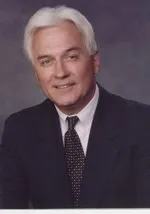
He served on the editorial board and was a reviewer for seven peer-reviewed journals. He authored 76 articles and book chapters, 27 published abstracts, and gave more than 350 professional presentations. He was very dedicated to resident education and research. He had a true passion for providing patient care that “is second to none” and was a strong force in establishing a trauma system in the state of West Virginia. The Peter Mucha, Jr., M.D. Memorial Lecture in Trauma and Critical Care has been established to continue his legacy of dedication to the trauma system and education of all healthcare providers.
Dr. J. Bishop McGill
Born in St. Johnsbury, VT, Bish was devoted to the University of Vermont, and to Fletcher Allen Health Care, where he practiced and taught surgery for more than 40 years.
Active in community and medical organizations, Bish co-founded the Northeast Medical Society, was a member of the New England Surgical Society, president of the Burlington Chamber of Commerce, and medical director for the Mt. Mansfield Ski Patrol at Stowe for decades.
Most importantly, Bish was passionate about caring for his patients and going for the gusto with his family and friends. That passion and gusto was a perfect fit for the WTA, where he and Betty joined their son, John, to enjoy the rich friendships, wonderful gatherings and fabulous skiing particular to the West. (The picture at left shows Bish and Betty celebrating their 50th anniversary.)
As his birthday fell during the week of the meeting, he dutifully prepared and transported in his ski bag a couple plastic saline containers of vodka sours to share the cheer and some of his McGill honey to distribute to needy WTAers.
Bish died peacefully at home in Stowe at the age of 85 from complications of Parkinson’s amidst family and, undoubtedly, with thoughts of floating down the steep and deep.
Dr. Ron Fischer, my mentor and friend, died Friday, January 25th after a long illness. He was born on January 29, 1936 in Philadelphia, PA and grew up in the Cincinnati, Ohio area. Having competed in the hurdles at Mariemont High School and making it all the way to the State Championships, Ron was awarded a full athletic scholarship in track and field from Ohio State where he graduated with a BS in Biology in 1957. He went on to medical school at the University of Cincinnati, during which time he met Nancy, who became his beloved wife of 51 years. Ronald completed his surgical residency under Dr. Owen Wangensteen at the University of Minnesota, where he also received his PhD in 1967. In 1968, Ron was sent to Vietnam and served as Chief of Surgery at the Saigon 3rd Army Field Hospital, receiving a Bronze Star for his service. While in Vietnam, Ron performed the first U.S. Army organ transplant (kidney). It was also the first to be performed in wartime and the first to be performed in Asia. He was promoted to Lieutenant Colonel while finishing his tour of duty at the Walter Reed Hospital in Washington, D.C.
Ron went on to a distinguished career as a general surgeon in academic medicine, starting as Assistant Professor of Surgery at the University of New Mexico Medical School in Albuquerque, NM. He then became Associate Professor of Surgery at the University of Minnesota Medical School, in St. Paul, MN where he was on the faculty with future WTA President Dr. Earl Young. Ron then served as Chairman of the Surgery Department at University of Arizona Medical School in Tucson, Arizona, where he established the first Trauma center in the state of Arizona. His next position brought him to Houston as Director of Trauma Surgery at University of Texas Medical School, where he worked with Dr. Red Duke to establish Hermann Hospital’s Life Flight Program as the country’s first and leading helicopter-based trauma center. I had the good fortune to be recruited to Hermann and UT by Ron in 1985, where I served as his assistant, sharing the responsibility for the Trauma Service with him. More importantly to me was his selfless and supportive role as my mentor, helping to shape my early and future academic career. One time, I mentioned how we were having difficulty with sepsis and renal failure in the Surgical ICU, and he sent me off to the St. Paul-Ramsey Hospital in Minnesota to learn about individualized antibiotic pharmacokinetics, which has continued to be a source of interest and investigation for me. He supported our development of a coagulation laboratory where we investigated the interactions of temperature on blood coagulation. And, notably, in 1989, he and Nancy brought Geri and I to Snowbird for our first Western Trauma Association meeting. Ron and Nancy had come to the Western Trauma Association meeting for their first time just one year earlier, and were so taken by the organization that they knew we should enjoy it with them. One of the most notable and influential WTA experiences they had was at that banquet their first year, right after Gene Moore had been elected President at the Business Meeting. Nancy had turned around to some commotion at the table behind them and said, “Ron, those people are having a food fight!” Ron turned around, saw the Moore brothers and friends in the fray and remarked, “Oh, that’s the President!” We knew then that this was clearly the kind of organization we would enjoy, and have done so for 25 consecutive meetings. We were later happy to help introduce our other UT Houston colleagues — Dr. Chris Cocanour, Dr. Rosemary Kozar, and Dr. Brent King — to the WTA.
Ron went on to become the first Chief of Surgery of the new LBJ Hospital in Houston and served on the Board of Regents of the American College of Surgeons. He retired in 1996, spending a number of years enjoying family and hobbies. At his recent passing, he was lucid toward the end while surrounded by loving family members. He was survived at the time by Nancy, their son Dr. Craig Fischer of Houston, TX, and their daughter Shannon Fischer Ware of Belleair, FL.
I regret that life is short but appreciate that memories are long. I also thank the Western Trauma Association for its ability to support and foster lifelong friendships. I ask for a moment of silence to remember Ron Fischer, loving husband, exceptional father, accomplished surgeon, and dear friend.
Thank you.
—Comments made by Dr. Larry Reed at the 2013 WTA Meeting
| Positions Held | Year |
| Program Committee | 1995-2004 |
| Nominating Committee | 1996-1999 |
| Board of Directors | 2001, 2006-2013 |
| Program Committee Chair | 2002-2003 |
| Secretary | 2006-2008 |
| Vice-President | 2009 |
| President-Elect | 2010 |
| President | 2011 |
| Immediate Past President | 2012 |
| Chair, Nominating Committee | 2012 |
Links to other reports on Gage’s passing:
American Association for the Surgery of Trauma Cutting Edge
Georgia Public Broadcasting
“Thank you for your mentorship and friendship. I use what you taught me every day and often think, ‘What would Ochsner do?’ You will be immensely missed. Thank you.”
Stephanie Gordy MD, FACS
Assistant Professor of Surgery
Acute Care Surgery and Surgical Critical Care
Michael E. DeBakey Department of Surgery, Baylor College of Medicine
Michael E. DeBakey VAMC
work:713-791-1414
cell:971-221-1969
stephanie.gordy@bcm.edu
See the letter from Immediate Past President David H. Livingston, MD
The Western Trauma Foundation is accepting donations in Gage’s name. Each contribution will be memorialized in this year’s program book with your name (not amount) and if you want, a short thought. The donation page will also be posted on the website.
Donations can be submitted through one of two processes:
Preferred method: Send a letter with your comments and check to:
Steven R. Shackford, MD, FACS
Scripps Mercy Trauma and Vascular
Suite 641
550 Washington Street
San Diego, CA 92103-2257
George Cierny III, MD, Scripps Mercy orthopedic surgeon and an active member of the Sharp Memorial medical staff, joined the WTA in 2001. George was born on December 12, 1947, in San Diego, California, the second of two children of George W. and Sylvia J. Cierny. He attended the University of Berkeley for his Bachelor of Arts degree and the UCLA School of Medicine for his Doctorate of Medicine. Following a residency in orthopedic surgery at the University of Texas, Dallas (Parkland Hospital), his education continued with fellowship training in clinical pathology and orthopedic oncology. George was an international professor of Orthopedic Surgery and published more than 100 scientific papers and book chapters in the field of musculoskeletal pathology and infection. He served as president of the Musculoskeletal Infection Society of North America and was a renowned physician and pioneer of the Cierny-Mader Classification System and Methodology accepted as a scientific standard in the treatment of osteomylelits.
He was the first orthopedic surgeon in the United States to apply and publish the principles of cancer treatment to the field of musculoskeletal infections. Dr. Cierny and his multidisciplinary team developed a comprehensive approach for the treatment of complex infections of bones and soft tissue , the non-union of long bones, bone loss, leg-length discrepancies, tumors and other limb-threatening conditions. He served as president of the Musculoskeletal Infection Society of North America.
George met his life’s partner, Doreen DiPasquale in Atlanta, where they were both working as orthopedic surgeons at Resurgen’s Orthopaedics and St. Joseph’s Hospital. After that they were inseparable, moving together to continue their careers in San Diego. George’s boundless energy and enthusiasm were also evident in his many hobbies: he was an incredible chef, avid gardener, great dancer, and he loved to surf and ride his bike in the hills of La Jolla.
Sadly, George passed away June 24, 2013 in San Diego after a difficult battle with pancreatic cancer. A scant six and a half months later, his soulmate Doreen passed on after him.
The Orthopaedic Research and Education Foundation has established the George C. Cierny III, MD Bone and Joint Musculoskeletal Infection Fund. Contributions can be made by mail to OREF/Cierny Fund, 6300 N. River Rd. Suite 700, Rosemont, IL 60018.
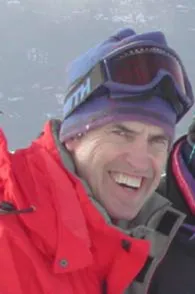
For those who were at the meeting in1994, few can forget the dramatic events immediately prior to that gathering. While skiing at Crested Butte on the Saturday before his Presidential Meeting was to start, Chris swerved to avoid hitting an errant women who’d veered into his path. He adroitly missed her, but planted his face into a tree, sustaining severe injuries. Gerry Gussack, the WTA Historian at the time, helped arrange an emergency evacuation for Chris to Denver, alerting the stunned receiving surgical resident there with the words, “This is the most important phone call you’ve ever had. The Chairman of Plastic Surgery at the University of Rochester has just sustained a LeForte III fracture at Crested Butte, and will soon be arriving in your facility…” Chris was whisked away from the meeting, deprived of his opportunty to present his Presidential Address or enjoy the meeting. Dave Kappel, then WTA Vice-President, presided over the 1994 meeting, as well as his own meeting at Big Sky in 1995, thereby becoming the only WTA member to preside over two annual meeitngs since founder Bob Volz (although Dave didn’t get the formal recognition).
Chris returned to the meeting the following year and for several years thereafter. After WTA Historian Gerry Gussack’s passing in 1997, Chris took on the mantle of WTA Historian and added significantly to the historical record of our organization. He initiated a series of interviews of Past Presidents, starting with Founder Bob Volz. Ten of those interviews are currently preserved on the WTA website.
In 2011, Chris came to the sad realization that his aging had gotten the better of him. He could not attend the meeting, but called in a speech to the membership and read a poem he’d written to the members of the Association. These were his words:
“On February 23, 1987 in Jackson Hole, Wyoming I was elected as a Director of the Western Trauma Association. I have served almost continually as a Director or Officer for the ensuing 24 years. My interest in helping the WTA has not waned, but health problems have rendered me less able. I am unable to meet my own standards. Thus, I am resigning my position as Historian. Note, I am not resigning from the WTA. To mark this day I have written a poem that tells how much I care about the WTA. God help me I do love you so.”
“The poem that follows is dedicated to the membership of the Western Trauma Association and to their families”
RESIGNATION – THE LAST RUN
by Christie Wray Jr.
March 2, 2011
For the Western Trauma Association
Honored was I To be asked
And gladly
Did I serve
Now in my minds eye
I have not skied
The last run with you
But time and illness
Demand their due
Nameless the last runners
Shall be
But known well to me
And to yourselves
And one another
I dream the last Run
Will look
Like this
Twenty three inches new
Tracks neither
Fore nor Aft
Old tower 3
Just close behind
With tower 3 chutes
Ahead
And all Jackson abounding
Now in my hearts eye
I have not skied
The last run with you
And
I never will
Chris and Rockye Wray at a WTA Welcome Reception
The following is excerpted from the Memoirs section of the American Association of Plastic Surgeons website:
A native of Arkansas, Chris Wray received his undergraduate degree from the University of Arkansas and graduated from Washington University School of Medicine, St. Louis, MO in 1963. His general surgery residency was at the University of Virginia Hospital, Charlottesville, VA from 1963 to 1970, which included two years of service in the United States Air Force. This was followed by a Plastic Surgery residency at Johns Hopkins Hospital, Baltimore MD, which was completed in 1972.
Chris served on the faculty of the Washington University School of Medicine in Plastic and Reconstructive Surgery from 1972-1983, achieving the rank of full Professor, under the tutelage of Dr. Paul Weeks. In 1984, he became Professor and Chair, Division of Plastic Surgery, University of Rochester, NY, holding that position until 1998.
In 1998, Chris joined the faculty at the Medical College of Georgia, Augusta, GA as Professor and Chief, Hand and Upper Extremity Service, a position he held until 2008. During his tenure, an award bearing his name was established for an outstanding resident. It states, “A man’s influence dies with him, a teacher’s influence goes on forever”.
Over the course of his career, Chris had numerous publications, book chapters and review articles. He was Associate Editor of Plastic and Reconstructive Surgery, the Journal of Hand Surgery, Annals of Plastic Surgery, and the Year Book of Hand Surgery.
He served as President of the American Association of Plastic Surgeons, the Association of Academic Chairmen of Plastic Surgery and the Western Trauma Association. He also served as Director and Vice Chair of the American Board of Plastic Surgery and was a member of the Residency Review Committee for Plastic Surgery.
Dr. Lee Caldwell, a colleague for fourteen years, remarked on his passion for teaching residents and medical students whether in conferences or in the OR. In remembering Chris, she says, “he was a genuine, understated, principled individual who consistently put others before himself”. One of his former residents, Dr. Brad Rockwell relates, “As residents, we could not have had a better teacher. As an academic plastic surgeon, I could not have had a better mentor. Dr. Wray shaped me, and others, as a surgeon. His lessons were always simple, straight forward, and easy to remember”.
Chris was a well conditioned athlete who enjoyed skiing, flying, golf and his 1962 Morgan!!
He is survived by his wife, Margaret Rothwell (Rockye) Wray, his children, Robert Christie Wray III, Anne Maury Bridges, Dr. Carter Wray and six grandchildren.
He was well loved and will be missed by all who had the privilege and pleasure of knowing him
Kenna S. Given, M.D.
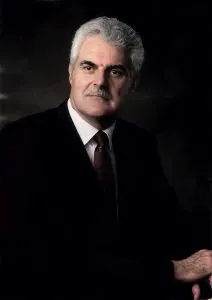
From Wikipedia:
Robert B. Ruthford, MD, (1931 – November 22, 2013) was an American vascular surgeon, scientific journal editor, and medical textbook author. He was best known for establishing the definitive textbook in vascular surgery as well as his role as Senior Editor of the Journal of Vascular Surgery.[1]
Early life and education
Bob was born in Edmonton, Alberta, Canada. He received his undergraduate degree (Phi Beta Kappa) in 1952 and his medical school education (Alpha Omega Alpha) in 1956, both from Johns Hopkins University. He received his surgical internship training at Johns Hopkins University School of Medicine, then a general surgery residency at the University of Colorado in 1963. During his surgical residency, he spent one year in Malmo, Sweden for a clinical fellowship year as a Fulbright Scholar at Lund University.
Career
Following the completion of his surgical residency in 1963, Rutherford served 2 years in the military at the Walter Reed Army Institute of Research. He then joined the surgical faculty at Johns Hopkins in 1965 before returning to the University of Colorado in 1970, where he spent the remainder of his professional career as Professor of Surgery. In 1977, he was appointed the first Chief of Vascular Surgery at the University of Colorado, a position he held until 1996, when he became Professor Emeritus.
During much of the latter half of his career, Dr. Rutherford worked diligently to bring uniform standards to the reporting of vascular practices in the professional literature, publishing a series of papers as chairman of the Committee on Reporting Standards of the Society of Vascular Surgery and the American Association for Vascular Surgery. Although he retired as Professor Emeritus in 1996, he continued editorial and committee work.
Vascular surgery textbook and legacy
In 1975, Rutherford recognized the need for a comprehensive textbook devoted exclusively to the new specialty of vascular surgery. He successfully recruited a group of peers to be associate editors, and in 1977, the first edition of Vascular Surgery was published. Over the next 30 years, Rutherford shepherded his textbook through six editions, constantly updating authors, content, and associate editors before assigning editorship to the Society for Vascular Surgery, who agreed to insure its publication in perpetuity. It has become the most widely used vascular surgery textbook worldwide.
In his Presidential Address to the Society of Vascular Surgery annual meeting in 1995, Rutherford emphasized the importance of uniform disease-specific reporting standards for describing vascular interventions, their results, and their complications. Rutherford organized the Society of Vascular Surgery committees that developed the current reporting standards, an initiative that expanded globally when he co-chaired the first TransAtlantic Consensus on Peripheral Arterial Occlusive Disease, in 2000. He also co-chaired the Transatlantic Consensus on Peripheral Arterial Occlusive Disease (TASC) in 2005. That same year, he was the recipient of the first Lifetime Achievement Award given by the Society of Vascular Surgery. At the annual meeting of the SVS in 2006 he was awarded the second annual Julius H. Jacobson II, MD. Award for Physician Excellence given by the Vascular Disease Foundation.
Rutherford served as Senior Editor of the Journal of Vascular Surgery from 1996 to 2003. He also recognized the need for regular updates of topics for practicing vascular surgeons, which led to his developing and editing Seminars in Vascular Surgery from 1988 to 2012.
Rutherford had broad interests in vascular surgery, a scholarly command of the literature, and an outstanding memory. This led to the publication over 400 scientific articles and book chapters on a wide range of topics during his career.
Honors and Awards
Rutherford was a member of many professional societies and was the President of four, including the International Society for Cardiovascular Surgery, North American Chapter, and American Association for Vascular Surgery. In 2005, the Society of Vascular Surgery awarded him its Lifetime Achievement Award.
Personal Life
Rutherford was married to his wife Kay for 58 years. They had five children. The life of one of their granddaughters was cut short at the age of eight due to complications related to diabetic ketoacidosis. In the granddaughter’s memory, the Rutherfords established the Brandi Rutherford Memorial Fund to support an annual lectureship and research initiatives in vascular surgery at Johns Hopkins School of Medicine in hopes of furthering knowledge of the relationship between diabetes and peripheral vascular disease.
References
- “Remembrances of 5 Leaders and Contributors in Vascular Surgery – Annals of Vascular Surgery”. www.annalsofvascularsurgery.com. Retrieved 2015-09-16.
- “Robert Rutherford Profile | Surgery | University of Colorado Denver”. www.ucdenver.edu. Retrieved 2015-09-16.
- “Robert B. Rutherford, MD, FACS, FRCS (1931−2013) A Tribute to the “Editor” Vascular Surgeon – Seminars in Vascular Surgery”. www.semvascsurg.com. Retrieved 2015-09-16.
- <“Robert B. Rutherford, MD, FACS, FRCS (1931−2013) A Tribute to the “Editor” Vascular Surgeon – Seminars in Vascular Surgery”. www.semvascsurg.com. Retrieved 2015-09-16.
- “Regarding “Presidential address: Vascular surgery—Comparing outcomes” – Journal of Vascular Surgery”. www.jvascsurg.org. Retrieved 2015-09-16.
- “Inter-Society Consensus for the Management of PAD” .
- “Journal of Vascular Surgery | Dr. Robert B. Rutherford”.
- “Robert B. Rutherford, MD, 1931-2013 Senior Editor, 1996-2003 – Journal of Vascular Surgery”. www.jvascsurg.org. Retrieved 2015-09-16.
- “SVS recognises Rutherford’s lifetime achievements”. Vascular News. Retrieved 2015-09-16.
- List, Shelley. “Vascular Surgery and Endovascular Therapy – Invited Lecture Series | Johns Hopkins Medicine”. Retrieved 2015-09-16.
–https://en.wikipedia.org/wiki/Robert_B._Rutherford
From the Journal of Vascular Surgery website:
Robert B. Rutherford, MD, died on November 22, 2013 at the age of 82. The vascular surgery community is saddened by the loss of this extraordinary man who is remembered for establishing the definitive textbook in vascular surgery, his role as Senior Editor of the Journal of Vascular Surgery, his numerous contributions to the care of patients with vascular disease, and his friendship and mentoring.
Dr Rutherford was born in Edmonton, Alberta, Canada. He received his BA (Phi Beta Kappa) in 1952 and his MD (Alpha Omega Alpha) in 1956, both from Johns Hopkins University. After internship at Johns Hopkins, he completed his general surgery residency at the University of Colorado in 1963. During residency, he did a clinical fellowship year as a Fulbright Scholar at Lund University in Malmo, Sweden. After residency, he served 2 years in the military at the Walter Reed Army Institute of Research. He was then appointed to the surgical faculty at Johns Hopkins in 1965 before returning to the University of Colorado in 1970, where he spent the remainder of his professional career as Professor of Surgery and Chief of the Vascular Surgery Section.
In 1975, Dr Rutherford recognized the need for a comprehensive textbook devoted exclusively to the new specialty of vascular surgery. He successfully recruited a group of peers to be associate editors, and in 1977, the first edition of Vascular Surgery was published. In the preface to the first edition, he stated in his usual humble manner that “our efforts will have been rewarded if the book proves helpful to any physician who has committed himself or herself to treating patients with vascular disease.” Over the next 30 years, Dr Rutherford shepherded his textbook through six editions, constantly updating authors, content, and associate editors before assigning editorship to the Society for Vascular Surgery, who agreed to insure its publication in perpetuity. Known colloquially as “Rutherford,” this textbook is a reflection of his vision and commitment and has become the definitive source for all practitioners of vascular health care. It is his enduring contribution to our discipline, for which we owe him a great debt of gratitude.
Dr Rutherford had broad interests in vascular surgery, a scholarly command of the literature, and an outstanding memory. This led to the publication over 400 scientific articles and book chapters on a wide range of topics during his career. He also recognized the need for regular updates of topics for practicing vascular surgeons, which led to his developing and editing Seminars in Vascular Surgery from 1988 to 2012.
Dr Rutherford served as Senior Editor of the Journal of Vascular Surgery from 1996 to 2003. He was a natural editor because he was an organized, experienced writer with an encyclopedic knowledge of the literature, who had had his own work critically reviewed many times. He was fair, balanced, and prepared to help less experienced authors. He continued to develop reporting standards during this phase of his career and to emphasize that studies should adhere to such standards. He recognized that professional bias, perhaps influence by secondary factors such as financial gain, could influence the interpretation of study results, and with K. Wayne Johnston, MD, he introduced routine disclosure of conflict of interest statements to the Journal. Further, he recognized that authors who publish the results of an industry-supported study could be perceived as being biased. He therefore introduced the policy that authors must have full access to all of the data in a study and take full responsibility for the integrity of the data, the accuracy of data analysis, and the writing of the manuscript.
Dr Rutherford was a member of many professional societies and was the President of four. Most notably, he served as the 43rd President of the International Society for Cardiovascular Surgery, North American Chapter (now the Society for Vascular Surgery). In his Presidential Address of 1995, he emphasized the importance of uniform disease-specific reporting standards for describing vascular interventions, their results, and their complications. Dr Rutherford organized the Society of Vascular Surgery committees that developed the current reporting standards. They are a major contribution to the advancement of our specialty, and this initiative expanded globally when he co-chaired the first TransAtlantic Consensus on Peripheral Arterial Occlusive Disease, in 2000.
In 2005, the Society of Vascular Surgery honored Dr Rutherford with its Lifetime Achievement Award. This is the highest honor that the SVS bestows on one of its members. It recognizes an individual’s outstanding and sustained contributions both to the profession of vascular surgery and to the Society, as well as exemplary professional practice and leadership.
Throughout his career, Dr Rutherford traveled widely as an invited speaker. Despite his many accomplishments, he remained a humble, friendly person who would always listen to colleagues and provide unselfish help in developing their careers. In mentoring young vascular surgeons, he encouraged them to pursue academic careers. This tall vascular surgeon with a sparkle in his eye was recognized around the world and appreciated by all.
Bob Rutherford and his wife Kay enjoyed downhill and cross-country skiing in the Colorado Mountains and sailing, windsurfing, tennis, and biking in Colorado at their summer home in Maine. In recent years, Bob enjoyed bird photography (especially in their winter home in North Padre Island), playing piano, fishing, and golf. His interest in new topics clearly extended to his recreational activities. He is survived by his wife of 58 years, their five children, and their many grandchildren.
Robert B. Rutherford was a surgeon-scholar who will be remembered most because he was a “teacher’s teacher” who conceived and edited the definitive vascular surgery textbook, lectured internationally, edited the Journal of Vascular Surgery, and stressed the importance of knowing outcomes through standard reporting. He made his scholarly mark on vascular surgery throughout the world through his enthusiastic work, friendships, mentoring of many colleagues, and his tireless writing and editing. It was a distinct honor to have worked with Bob on many projects over the years and to have become close personal friends with him. He is deeply missed by his many friends and colleagues in the global vascular community.
–http://www.jvascsurg.org/article/S0741-5214(14)00002-0/fulltext
From the University of Colorado Department of Surgery website:
Robert B. Rutherford was the face of Vascular Surgery at the University of Colorado School of Medicine and the CU Department of Surgery for almost three decades from 1970 to 1996. However, his association with CU started with general surgery residency training at CU from 1957-1963, including a Fulbright Scholarship for training in Sweden in 1961-1962. Following an additional two years of research at Walter Reed, Dr. Rutherford then joined the Johns Hopkins surgical faculty in 1965. In 1970 he returned to CU as an Associate Professor.
In 1975 Dr. Rutherford established the first non-invasive vascular diagnostics laboratory between St. Louis and San Francisco. By 1976 he had been promoted to full Professor of Surgery with tenure. In 1977 Vascular Surgery was recognized as a surgical specialty and Dr. Rutherford was appointed as the first chief of Vascular Surgery at CU. Dr. Rutherford’s textbook Vascular Surgery, first edition of now seven, was first published in 1977 and remains the authoritative text for vascular surgery.
During much of the latter half of his career, Dr. Rutherford worked diligently to bring uniform standards to the reporting of vascular practices in the professional literature, publishing a series of papers as chairman of the Committee on Reporting Standards of the Society of Vascular Surgery and the American Association for Vascular Surgery. Although he retired as Professor Emeritus in 1996, he did not retire from his prominent position as a voice for Vascular Surgery nationally and internationally. This work continues, as evident by Dr. Rutherford’s editorial and committee work.
Dr. Rutherford co-edited the “Journal of Vascular Surgery” from 1996-2003. Dr. Rutherford co-chaired the Transatlantic Consensus on Peripheral Arterial Occlusive Disease (TASC) in 2005. That same year, he was the recipient of the first Lifetime Achievement Award given by the Society of Vascular Surgery. At the annual meeting of the SVS in 2006 he was awarded the second annual Julius H. Jacobson II, MD. Award for Physician Excellence given by the Vascular Disease Foundation. The seventh edition of Rutherford’s Vascular Surgery was published in 2010.
Doreen Lynn DiPasquale, MD, was an orthopedic surgeon who became a member of the Western Trauma Association in 1998. She was born on August 26, 1952 in Detroit, MI, the first of three children of Marlene and Richard A. DiPasquale. Doreen attended school in the Detroit area, and was a competitive and synchronized swimmer and on the homecoming court at Bloomfield Hills Lahser High School. She attended the Henry Ford School of Nursing and was an R.N. for 5 years in MI, WA, and VA before enrolling at George Washington University in Washington, D.C.
She completed her Bachelor of Science and Doctor of Medicine degrees, with Academic Honors, at G. W. in 1985. Doreen did her residency in Orthopaedic Surgery at the university and became Senior Attending Department of Orthopaedic Surgery at the Washington Hospital Center as well as Residency Director and Assistant Professor at George Washington University and Children’s National Medical Center in Washington, D.C. After training on Ilizarov Method of Osteosynthesis and Traumatology in Kurgan, Russia and Lecco Italy, Doreen became a pioneer of the method and was recognized as a leader in her field, lecturing at various symposiums around the world. She also conducted extensive clinical research and published numerous original articles and book chapters on topics related to musculoskeletal infection, extremity injury, and limb salvage.
Doreen left the Washington Hospital Center in 2003 to become a Consultant Physician at Resurgen’s Orthopaedics and St. Joseph’s Hospital in Atlanta, GA where she met the love of her life, George Cierny III, MD, also a WTA member. Doreen served as president of the Limb Lengthening and Reconstruction Society and was active in the American Academy of Orthopaedic Surgeons, the Musculoskeletal Infection Society of North America, the European Bone and Joint Infection Society, as well as the Western Trauma Association.
Doreen and George established a private practice together in San Diego in 2006 and were very successful helping people with extremely complicated surgical and infection issues, utilizing their unique and world-renowned Orthopaedic skills. Doreen was a brilliant educator and excellent mentor to medical students, residents, nurses, physicians, and patients. Working with Doreen in the clinic or hospital was always a pleasure. In addition to providing extraordinary care to her patients, one quickly learned that she possessed a wonderful wit as well as a wide fund of knowledge about many other aspects of life, making her an enjoyable colleague even when subjects were not purely medically focused.
Doreen enjoyed travelling and was also a student of art most of her life, becoming an accomplished Oil and Acrylic artist and member of the La Jolla Art Association where her paintings were on exhibit from time to time since 2009.
Doreen passed away January 7, 2014 unexpectedly in her sleep while recuperating at Sharp Memorial Hospital in San Diego, CA. She is survived by her mother Marlene Zdral, brother Richard M. DiPasquale and, sister Pamela A. DiPasquale Lehnerz. Doreen was preceded in death by her loving husband, George, who passed away tragically from pancreatic cancer a short six and a half months before her passing.
Published in The San Diego Union Tribune on Feb. 2, 2014 – See more at: http://www.legacy.com/obituaries/sandiegouniontribune/obituary.aspx?pid=169440471#sthash.Q4Q0QzrH.dpuf
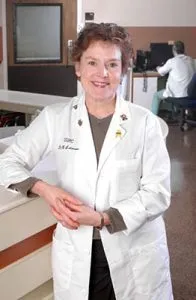
In 1977 Barbara married an Air Force pilot and once again began the cycle of moving. The couple finally settled in Las Vegas, NV. While her husband was stationed overseas, she completed medical school at the University of Nevada, graduating in 1985, and completed her surgical residency in Las Vegas. The couple divorced in 1986. Barbara accepted a trauma fellowship at the hospital of University of Pennsylvania in Philadelphia, the first women to attain that goal. After the fellowship she became the Medical Director of PENNSTAR, the hospital’s helicopter team. From 1992-1998, she worked in Pittsburg, PA as a trauma and burn surgeon. She bought a turn of the century home in the historic Shadyside area and spent the next five years restoring the home to its original grandeur. It was during this time that Barbara volunteered for Doctors Without Borders and went to Bosnia during the war. She also volunteered her time and professional expertise in Bosnia during the war, as well as India, Nepal, and Zambia (and probably some other countries as well), in addition to Operation Safety Net (a wonderful program delivering medical care to the homeless on the streets of Pittsburgh). Barbara had a brilliant mind, many talents (including music, house renovation, needlework), a very generous heart, and a tremendous will to live life at its fullest. She was determined to see as much of the world as possible, and she pretty much did. During her life, she visited every continent except Antarctica, and many of the places she visited she did so as a doctor, helping everyone from burn victims in Katete, Zambia, to victims of the Bosnian War to Tibetan refugees in India and Nepal.
In 1998, Barbara became the Burn Center Director at Cook County Hospital in Chicago. In 13 months, she transformed the burn unit into a fully verified burn center. She then supervised the relocation of the entire center into the new Stroger Hospital in 2002. In 2004, she accepted the position as Burn Center Director at the University of Iowa. She purchased the historic Milton Rumley house and completely restored the mansion to its original splendor. She was also appointed the Clara L. Smith Professor of Burn Treatment. During her tenure, she received numerous research grants, resulting in over eighty peer-reviewed publications.
Barbara’s dedication to international burn care and prevention took her to over ninety countries including the remote areas of Tibet, Nepal, India, Bangladesh, the Australian outback and Zambia. She was responsible for getting a burn unit built in the mission hospital in Katete and worked with the local people there teaching burn safety, care and prevention. She also co-founded the International Outreach Committee of the American Burn Association.
Tragically, Barb succumbed to a glioblastoma multiforme on June 15, 2015 after a battle lasting 2½ years. The Barbara Latenser Memorial Scholarship was established by the From Tragedy To Triumph Foundation (FTTTF).
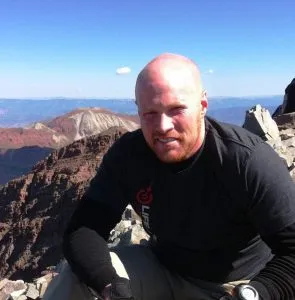
Matt was born on July 29, 1974 in Galveston, TX. He received a Bachelor of Science degree in Chemistry from Tarleton State University in Stephenville, Texas. He went on to receive his Doctorate in Medicine with honors from The University of Texas Medical Branch in Galveston. He completed his internship and residency in General Surgery at Scott & White Hospital and the Texas A&M University Health Sciences Center in Temple, TX. He finished his training by completing a Fellowship in Trauma and Critical Care at the R. Adams Cowley Shock Trauma Center/The University of Maryland in Baltimore, MD in 2008.
From there, Matt returned to Texas and took a position as a faculty member at the Texas A&M University Health Sciences Center in Temple, TX. He was appointed as the Director of Trauma, Baylor Scott & White System, Central Region.
His new role was seriously tested on November 5, 2009 when he and his team managed multiple casualties resulting from a shooting spree by Major Nidal Hasan at nearby Fort Hood. The trauma center at Scott & White cared for 10 of the victims as well as the shooter. The event received national attention, which was repeated nearly 5 years later, on April 2, 2014, when another mass shooting occurred at Fort Hood, with the Scott & White trauma center caring for 16 wounded victims. Matt reported on these two events at the 2015 meeting of the Western Trauma Meeting in and abstract entitled “When Lightning Strikes Twice: Fort Hood and the Value of Experience.”
Just a few months later, on September 3, 2015, Matt’s young and promising career was suddenly and tragically ended following a mountain climbing accident at Crestone Needle in the the Sangre de Cristo Range of southern Colorado (Matt’s ascent route is pictured above). He was survived by his wife, Sharron, and their three children.
The following is from Matt’s obituary in the Alvin (TX) Sun:
“Matt wore many hats throughout his life, but he pursued each role with intensity and compassion. Matt was a loving husband, a doting father, a caring son, a quintessential big brother, a fierce friend, a selfless servant, a gifted surgeon, and a fearless leader. Matt’s love for people, adventure, good jokes, good bourbon, mountains, his kids, and meal-time prayers were some his trademarks. His faith, friendship, courage, compassion and infectious laugh will be remembered forever. He climbed mountains for the same reasons he treasured his wife for 20 years, loved his kids with all his heart and saved lives in the trauma unit – he was committed to the pursuit of a well-lived life for the glory of God, and he has accomplished it.
“Two memorial services were held at Baylor Scott and White Memorial Hospital in the Mayborn Auditorium in Temple on Friday the 11th. A memorial service for close friends and family was held at his home in Belton on Friday evening. Matt’s ashes were spread on the top of Quandary Peak near Breckenridge, Colorado on Sunday the 13th. More than two dozen family and friends hiked to the top of this 14,265-foot peak to participate.”
Art McGuire was born in Minneapolis on Feb. 20, 1933. He was the fifth President of the Western Trauma Association, serving in that role for the 1975 meeting in Sun Valley.
Art was the son of the late Arthur McGuire and Dorothy Merritt McGuire. He was an honorable member of the U.S. Army stationed mainly in Europe. Some of his career accomplishments include:
- commander of the 67th Combat Support Hospital in Kuwait
- deputy commander of the UN Forces Military Hospital in Zagreb, Croatia, and
- surgeon-on-call for the NASA Space Shuttle Program.
Upon retirement from the U.S. Army, he served as chief of surgery at the Veterans Administration Hospital in Fayetteville, where he continued to earn the respect of patients, colleagues and staff.
His passion was sailing. He was a licensed master captain and spent many happy hours on his sailboat WingN’Prayer.
Art was survived by his wife, Celia “Kelly” McGuire; sons, Scott McGuire of Apple Valley,Minn., Christopher McGuire (Daniella) of Bozeman, Mont., and Carsten Brand-Kottenhagen (Ulrike) of Berlin, Germany; daughters, Kathryn McGuire (Phil Lodwick) of Bloomington, Minn., Kirsten Stray (James) of San Mateo, Calif., and Claudia Collins of Elizabethtown, Ky.; sister, Martha Marchand (William) of St. Paul, Minn.; and 11 grandchildren.
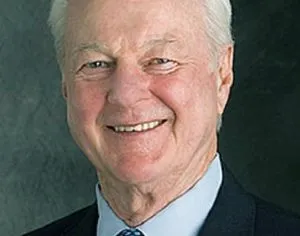
Glen Nelson passed away on May 14, 2016. He was the 7th individual to be WTA President (8th in succession because our founder, Bob Volz, served two terms). He oversaw the first meeting at Steamboat, one of the WTA’s most popular meeting sites.
Glen was born March 28, 1937, in Minneapolis, Minnesota.He was the son of husband and wife pharmacists Ralph David Nelson and Edna Mae Nelson. His first job, at age 10, was as clerk at the neighborhood drugstore, Griffin Pharmacy, owned and operated by his parents. Glen received a Bachelor of Arts degree from Harvard College in 1959. While there, he met fellow Edina High School graduate, Marilyn Carlson, at a mixer at Smith College. The couple married in 1961 following her graduation at Smith and shared 54 years of marriage, passion, and partnership. Marilyn once said, “I had the extraordinary good fortune to marry a man who was different from me he was more left brain, a scientist, brilliant.”
Glen received his MD from the University of Minnesota. He performed general surgery from 1975-1986 at Park Nicollet Medical Center, a large multi-specialty group practice where he became President and CEO. He also helped launch and grow American MedCenters as its chairman and chief executive officer.
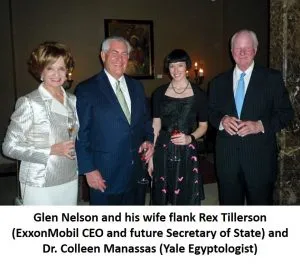
He was viewed as a thought leader in the health care space and served as a board member advising more than twenty companies over time. Glen’s wisdom, analytical abilities, and strong moral compass were qualities recognized by many other enterprises, and he served on for-profit and non-profit boards including: Minnesota Public Radio, Harvard University Dean’s Council, Johns Hopkins Medicine Board of Advisors, The Jackson Hole Group, and Travelers Insurance. He was a founding member of the board of Carlson, the privately held company founded by his father-in-law Curt Carlson, and also served on the Carlson Holdings Board of Governors.
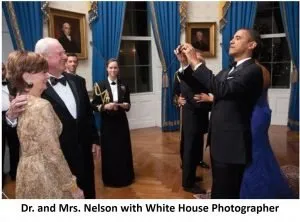
Glen and Marilyn made family the center of their lives, hosting holiday celebrations, attending school “grandparent” days and Minnesota Wild hockey games, and providing uconditional love to all. Each grandchild treasures the special memories of the travel adventures he meticulously planned and executed. He was a loving, inspiring and enduring model. He was the bedrock foundation for family life. Glen is preceded in death by his parents, daughter Juliet Evans Nelson, and brother Jon Robert Nelson. He is survived by his wife Marilyn Carlson Nelson, children Diana Lynn Nelson (John Atwater), Curtis Carlson Nelson, Wendy Martin Nelson, and grandchildren Alexander and James Muresanu, Juliet and Jennifer Nelson, Martin and Sadie Nelson, as well as step-grandchildren, Thea, Jack and Thomas Atwater.
–Excerpted from the Star Tribune May 18, 2016:
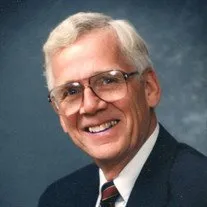
His name appears in the WTA Historical Documents, showing up in 1975-1976 listing of the membership. At that time, he was working at the University of Michigan Hospital in Ann Arbor, MI.
The following text was displayed online by the Jowett Family Funeral Home:
“William R. Olsen, MD, 85, of Frankfort, Michigan, passed away June 14, 2017, due to complications from a heart attack while biking his beloved Betsie Valley Trail. He is survived by his wife and soul mate of 67 years, Joan Jacobsen Olsen, his sons William (Joanne) Olsen, David (Julie) Olsen, and his daughter Kristine (Daniel) Drake. He leaves behind six grand children, two great-grand children, nieces, nephews, and his sister Kristine Olsen Clark.
“Bill was born in Frankfort, Michigan, to William Reidal Olsen and Agnes Christine Nelson July 11, 1931. He graduated from Frankfort High School in 1949. After graduating from Michigan State College, he continued his education at the University of Michigan in Ann Arbor. Bill received his medical degree in 1957 and completed his residency in general surgery in 1962. After serving many years as a member of the faculty at the University of Michigan Department of Surgery, he practiced at St. Joseph Mercy Health System, where he served as chief of surgery and chief of staff. He published many articles in academic journals, including the New England Journal of Medicine.
“After retiring, he and his wife Joan returned to Frankfort in 1991. In addition to being an avid sailor and skier, Bill devoted his retirement years to the community and the Betsie Valley Trail. The ribbon cutting ceremony for the Betsie Valley Trail on June 28, 2003 is among one his most cherished memories.
“Bill was named the Benzie County Chamber of Commerce Citizen of the Year in 2005, and was inducted into the Frankfort–Elberta Area Schools Hall of Fame in 2011.
“Bill’s family encourages friends to get out and enjoy the trail he loved so much, and to consider a contribution to the William R. and Joan Olsen Endowment for the Friends of the Betsie Valley trail (www.gtrcf.org/give/our/funds.html/243 ) or the Grand Traverse Regional Land Conservancy (www.gtrlc.org ).
“Per his wishes, family and friends are planning to gather for a celebration of his life, which will take place sometime in the fall. Arrangements by Jowett Family Funeral Home & Cremation Service.”
There were also several comments placed online by physician colleagues of his:
“Dr. Olsen was at st Joe’s when I rotated through as a UM general surgery resident. He was a gifted surgeon and a true gentleman. I learned much from him as I cycle now, will come ride the trail sometime soon to honor his legacy.” – James Geiger – June 25, 2017 at 09:15 AM
“Dear Joan and family, Joan and I were saddened to hear of Bill’s sudden death, and are very sorry for your loss. We have many happy memories of you both who were always so kind to us. Bill was a valued mentor, colleague, and friend and we spent many productive and educational hours in the OR together over the years. All of us in the Coller Society will miss him. Please accept our deepest sympathies. Tom and Joan Dent” – Thomas L. Dent – June 22, 2017 at 01:25 PM
“Sorry to hear of Bill’s demise. A hard worker worthy of trust and respect. Bill was an outstanding skilled surgeon! I was proud to have been his partner and his friend!” – Richard O. Kraft – June 22, 2017 at 09:54 AM
“What a great colleague. fellow medical student, fellow resident, fellow traveler, husband, family member and contributor to society in so many ways. Loved Bill and Joanie and their family. Gordi Hyde” – Gordon Hyde MD – June 20, 2017 at 01:48 PM
“We were so very sad to learn about Bill’s passing. We treasured our annual summer meetings with him and Joan when we had our cottage in Leland. We took turns meeting for dinner either in Traverse City or in Suttons Bay/ Lake Leelanau……or once, on the beautiful sailboat. He was always the most athletic and fit person our age that we knew. Our children all remember him from the Coller Society ski trips. We all send our love and our condolences to Joan and to the whole beautiful family. Marty and Marilyn Lindenauer” – Marilyn & Marty Lindenauer – June 21, 2017 at 10:58 AM
“Bill Olsen was truly a consummate surgeon — one who gave so much of himself to so many — patients, students of surgery, his community, and colleagues alike. May he rest in peace. Special blessings to Joan and Bill’s family. Nick and Kathy Feduska, East Renton Highlands, Washington” – Nicholas J. Feduska, M.D. – June 25, 2017 at 08:58 PM
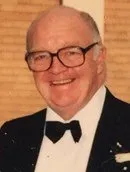
Erick Ratzer was the 11th individual to become President of the Western Trauma Association. He presided over the meeting at Vail in 1982. You can find his name listed as one of the “Paid Members” in the WTA Historical Documents. He had practiced as a general surgeon in Littleton, Colorado, for nearly his entire career.
Erick was born in Evanston, IL to Emily and Erick Ratzer on October 14, 1932. He went to school at Evanston Township High School, Evanston IL. He married Jeanne Ann Mason on June 12, 1954 in Evanston, IL. He attended DePauw University and Northwestern University and graduated from George Washington University Medical School. He practiced medicine in the Denver area for over 35 years and was a well-respected surgeon. He was an Air Force Reserve veteran.
He was heavily involved in The Western Trauma Association and Denver Academy of Surgery and a past president of both. He enjoyed basketball, skiing, squash and was an accomplished golfer.
He passed away on Friday July 7, 2017, peacefully at home. Erick is survived by his wife Jeanne and six children, Sarah (Damon) Endicott, Bob (MaryEllen) Ratzer, Elizabeth (Jim) Taflan, Barbara (Kenny) Anderson, Richard (Michelle) Ratzer and Philip (Jane) Ratzer, 15 Grandchildren and 4 Great Grandchildren.
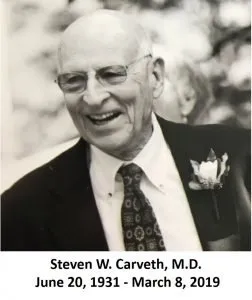
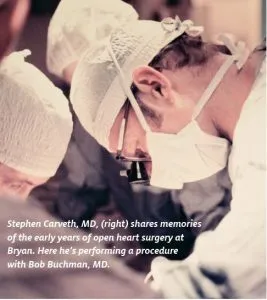
In 1973, he created an emergency dysrhythmia recognition course for the treatment of cardiac patients. This course eventually became known as Advanced Cardiac Life Support (ACLS), which ultimately became associated with the American Heart Association. In that effort, he worked closely with the Lincoln Medical Education Foundation, an organization that also contributed strongly to the development of the Advanced Trauma Life Support (ATLS).
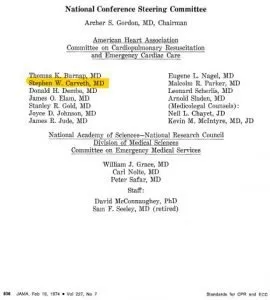
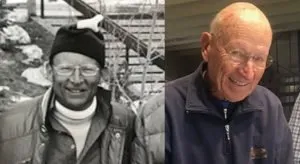
Steve’s surviving family members included his wife Beth; children William Carveth from Fresno, California, Carolyn Otte and Jim Carveth (both in Lincoln) step-children Julie Batug and Jim Ness (both in Denver, Colorado, along with 10 grandchildren, 7 great-grandchildren and several nieces and nephews.
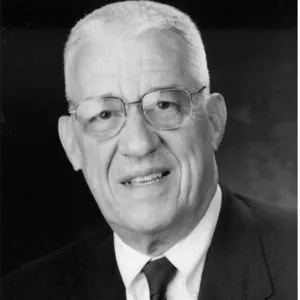
Basil was born in Nyack, New York, to Basil A. Pruitt and Myrtle Florence (“Flo”) Knowles Pruitt on August 21, 1930. After graduating from high school in Dallas, he continued his education at Harvard College (class of ’52), majoring in geology. Instead of devoting his future to rocks, to the benefit of so many future patients he instead chose to go to medical school (Tufts, class of ’57), then on to a surgical residency at Boston City Hospital. While a resident, he was drafted into the US Army and was sent to Brooke Army Medical Center and to what would later be renamed the Institute of Surgical Research (ISR). Having found his calling conducting research and caring for severely burned and injured patients, he completed his residency at Brooke in 1964 and then returned to the ISR. In 1967 she spent a year in Vietnam as the Chief of Surgery of the 12th Evacuation Hospital in Cu Chi, returning in 1968 to become Commander and Director of the ISR, where under his leadership over the next 27 years his unit’s prolific work led to unprecedented improvements in trauma and burn care.
After retiring from the Army in December 1995 after 35 years of active duty, he joined the faculty of the UT Health Science Center at San Antonio as Professor of Surgery. He served as Editor-in-Chief of the Journal of Trauma for 17 years, was elected as the president of 12 surgical societies, published over 650 peer-reviewed papers, textbooks chapters and books, and was the recipient of numerous national and international awards for his work.
During his long career, he served as a teacher and mentor to countless surgeons and other health care providers, many, if not all, with whom he developed lifelong friendships that brought him much joy. Among his favorite pastimes outside of work were tennis, downhill skiing, savoring good food and fine wine in the company of friends, traveling, spending holidays with family and collecting Japanese woodblock prints with his wife Molly. He was also s consummate storyteller and loved a good joke.
Basil is survived by his wife of 64 years, Mary “Molly” Gibson Pruitt, and their three children, Jeffrey H. Pruitt of Dallas, Laura S. Pruitt of Washington, DC, and Scott K. Pruitt of Durham, NC; Scott’s wife, Sandy Heard; four grandchildren, Sara O. Pruitt, Samuel H. Pruitt, Sydney R. Pruitt and Seth H. Pruitt, who affectionally referred to him as “GB”, and his brother, John Pruitt and his wife, Marianne MacLeod Pruitt, of Dallas.
Donations in memory of Basil A. Pruitt, Jr., may be made to the Texas Burn Survivor Society, https://texasburnsurvivors.org/donate.
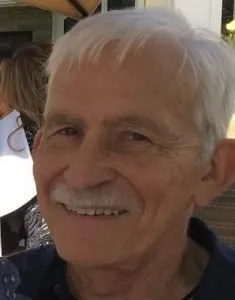
Peter was an orthopedic surgeon in Billings, MT, at St. Vincent’s Hospital (where he was twice Chief of Staff), the Shriners Hospital for Children, the Indian Health Service in Crow Agency, and the Veterans Administration. He also served with Doctors Without Borders in Vietnam in 1994.
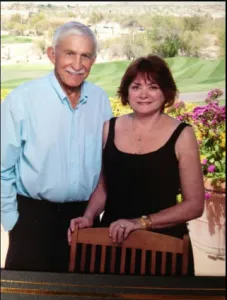
He retired from surgery practice in 1998 and went on to work for the Veterans Administration part-time for several years. He spent his retirement between Billings and Tucson, AZ, as well as spending time in France for many years. He loved woodworking and golfing and was eternally learning French. Peter became a tireless amateur artist after retirement, taking classes in watercolor painting and drawing. Everywhere Peter went, his sketchbook and a case full of pencils and brushes came with him.
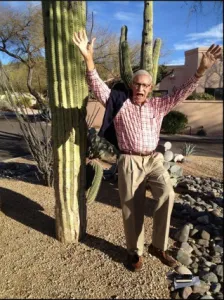
Remarkably, Peter passed from this life on the eve of the 50th Anniversary Meeting of the WTA, at the age of 86 (six days shy of his 87th birthday). At the start of the 2020 meeting in Sun Valley, Idaho, his WTA co-founder Bob Volz sent the WTA Membership the following letter:
“Members of the Western Trauma Association,
“It is with deep sorrow that I share with the membership of the Western Trauma Association the passing of a cherished friend, Dr. Peter Teal, Co-Founder of the WTA, on February 8, 2020, in Tucson, Arizona.
“My friendship with Peter began in 1943, when we first met as two eleven-year-old boys, far from home, at a boy’s camp in Northern Minnesota. Little could we then imagine how our lives would be intertwined over the ensuing seventy-seven years, ending with my presence at his bedside during his last days.
“Peter was raised in a family of talented and creative parents, an intellectual background that favored his admission to Dartmouth College, followed by Harvard Medical School, 1951-1959. His Orthopedic Residency training was completed at the Hennepin County Medical Center, Minneapolis, Minn.
“He entered private practice in partnership with Dr. Perry Berg, in Billings, Montana and remained there until his retirement in 1998. He will be remembered as a quiet thoughtful friend, as an avid reader, a gifted painter, a capable bridge player, an enthusiastic skier, a private plane pilot and a third-world medical volunteer.
“He is survived by his wife Anne (Braafeadt) Teal, brothers John and Thomas ‘Topper’ and sister Alison Teal Brown, 4 children, Pete Teal, Cynthia Crist, Mallory Gilbertson, and Emmy Denny, and many nieces and nephews along with a host of admiring friends who were fortunate to have crossed his path.
“Dr. Robert Volz”
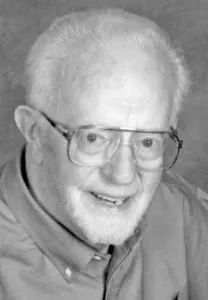 Robert Edmondson passed away peacefully after a long and full life. He was born and raised in Waukesha, WI, discovering a love of music and the great outdoors and developing an interest in medicine from his physician father. After graduating with honors from the University of Wisconsin School of Medicine in 1954, Bob’s irrepressible wanderlust took him to Philadelphia, two years of medical service in the army in France, Boston, where he met and married Ann Tomlinson, his wife of 62 years, Cleveland, Salt Lake City, and finally Woodland. Bob joined the Woodland Clinic Medical group in 1961 as the first hematologist in the practice. He was a Fellow of the American College of Physicians, certified by the American Board of Internal Medicine in Hematology and Medical Oncology and enjoyed teaching hematology as a Clinical Professor at the University of California at Davis for 28 years. Bob was known for his thorough and sensitive treatment and management of the challenges of a cancer diagnosis and for his care in counseling families to accept their victories and their defeats. In his own quiet and thoughtful way, he improved the quality of life for many in the community and beyond. Bob and Ann were founding members of the Woodland Presbyterian Church which was established in 1966. Over the past 54 years, they have been contributing members of the Session, Deacons, Land and Building committees. Bob was the church organist for more than 40 years. He was also a founding member of the Woodland Chamber Singers and served as the director until 2007. He kept an active schedule of musical performances, trips around the world, and socializing. In later years a hereditary memory condition limited his activities but not his chipper mood and clever sense of humor. Bob left the world a better place for his efforts. Bob was a devoted husband and proud father of Jim, a retired neurologist in New York City, and Susan, a scientist in Cambridge MA. Bob is survived by his loving wife, Ann; his son, Jim and wife Patricia; their sons, Alexander and Eric; and his daughter, Susan, her husband, Allen Rutberg and their children, Benjamin and Nathan. A memorial service is necessarily postponed due to shelter-in-place constraints. In lieu of flowers, donations may be made to the Robert Edmondson Memorial Fund at the Woodland Presbyterian Church, 1324 Columbia Drive, Woodland, CA, 95695.
Robert Edmondson passed away peacefully after a long and full life. He was born and raised in Waukesha, WI, discovering a love of music and the great outdoors and developing an interest in medicine from his physician father. After graduating with honors from the University of Wisconsin School of Medicine in 1954, Bob’s irrepressible wanderlust took him to Philadelphia, two years of medical service in the army in France, Boston, where he met and married Ann Tomlinson, his wife of 62 years, Cleveland, Salt Lake City, and finally Woodland. Bob joined the Woodland Clinic Medical group in 1961 as the first hematologist in the practice. He was a Fellow of the American College of Physicians, certified by the American Board of Internal Medicine in Hematology and Medical Oncology and enjoyed teaching hematology as a Clinical Professor at the University of California at Davis for 28 years. Bob was known for his thorough and sensitive treatment and management of the challenges of a cancer diagnosis and for his care in counseling families to accept their victories and their defeats. In his own quiet and thoughtful way, he improved the quality of life for many in the community and beyond. Bob and Ann were founding members of the Woodland Presbyterian Church which was established in 1966. Over the past 54 years, they have been contributing members of the Session, Deacons, Land and Building committees. Bob was the church organist for more than 40 years. He was also a founding member of the Woodland Chamber Singers and served as the director until 2007. He kept an active schedule of musical performances, trips around the world, and socializing. In later years a hereditary memory condition limited his activities but not his chipper mood and clever sense of humor. Bob left the world a better place for his efforts. Bob was a devoted husband and proud father of Jim, a retired neurologist in New York City, and Susan, a scientist in Cambridge MA. Bob is survived by his loving wife, Ann; his son, Jim and wife Patricia; their sons, Alexander and Eric; and his daughter, Susan, her husband, Allen Rutberg and their children, Benjamin and Nathan. A memorial service is necessarily postponed due to shelter-in-place constraints. In lieu of flowers, donations may be made to the Robert Edmondson Memorial Fund at the Woodland Presbyterian Church, 1324 Columbia Drive, Woodland, CA, 95695.
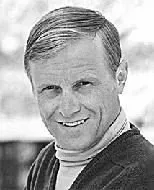
George E. Pierce, M.D. Dr. George E. Pierce of Austin, Texas (formerly of Lake Quivira, Kansas) passed away on June 18, 2020 at the age of 86. He was born to Jessie and George Pierce in Washington, Iowa in 1933. He grew up in his beloved Wyoming where he graduated Phi Beta Kappa and Summa Cum Laude from the University of Wyoming. Following his senior year in college he was nominated for the Rhodes scholarship. He went on to earn a Master’s degree in Biophysics and a Medical degree from The Johns Hopkins University, on a scholarship. At Johns Hopkins he served his surgical internship and residency under Dr. Alfred Blalock, his esteemed mentor. Dr. Pierce served at the National Institutes of Health, the National Heart Institute, Bethesda, Maryland. Additionally, he undertook training in the emerging subspecialty of vascular surgery at the University of Washington. Dr. Pierce went on to become a major contributor to the advancement of kidney transplantation. He practiced vascular and thoracic surgery for more than 40 years, holding positions at the University of Washington, the University of Colorado, the VA Medical Center and finally at the University of Kansas School of Medicine, where he served as a distinguished clinical Professor of Surgery. As a surgeon, teacher, researcher, and mentor to generations of physicians, Dr. Pierce led many, inspired others and helped thousands of patients. He was the author, co-author or editor of scores of scientific papers and the inventor of several patented surgical medical devices. Professional leadership positions included many with the American Surgical Association, the Halsted Society, the American Society of Transplant Surgeons, the Transplantation Society, the National Kidney Foundation, the Midwest Organ Bank, the Midwestern Vascular Surgical Society, the Society for Vascular Surgery, the International Surgical Society, the International Society for Cardiovascular Surgery, the Society of University Surgeons, the Association for Academic Surgery, and the Western Trauma Association. An avid outdoorsman, he never lost his love of the Rocky Mountains and his fondness for skiing, hiking and fishing, passions he instilled in his children and grandchildren. He also had a life long love of music, ranging from classical music to country western and could play the piano by ear. He looked forward to mountaineering expeditions, spending time on his ranch in Montana, and skiing with his children and grandchildren. He was commonly known as “One More Run George” for seizing every opportunity on the ski mountain before the day’s end. He lived his life the same way, whether pushing higher on the mountain or pushing himself further. Those left to cherish his memory include his devoted wife of 57 years, Carolyn Bell Pierce (Austin, TX), whom he met on a blind date in Baltimore, Maryland while a young intern at Johns Hopkins. Other family members include his daughter Cathryn Lynn Pollinger (Austin, TX), son William Brooks Pierce (Mission Hills, KS), grandchildren Jenny, Ben, Alexandra, and William, son-in-law Steve Pollinger (Austin, TX), daughter-in-law Amy Freeman Pierce (Mission Hills, KS), and sister Ruth Bramall (Lake Stevens, WA). The family wishes to thank his devoted caregivers at Querencia in Austin, Texas for the compassionate care afforded Dr. Pierce. In lieu of flowers the family suggests contributions be made in Dr. Pierce’s name to The Johns Hopkins University School of Medicine or the University of Kansas School of Medicine.
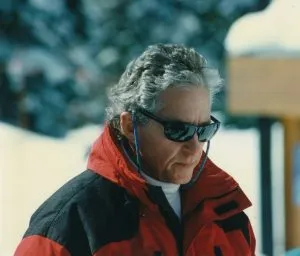
Born in Pittsburgh, Harvey was the David M. Hume professor of surgery at the VCU School of Medicine and chief of the Division of General/ Trauma Surgery from 1978 to 2003, during which time he operated on thousands of patients. Never one to sit still, following retirement, Harvey became Editor-in-Chief of Surgery of Obesity and Related Diseases (SOARD), while simultaneously pursuing the invention of an abdominal device to cure preeclampsia. He spent three years as a surgeon in the U.S. Army and served as president of the Western Trauma Association (2004) and American Society for Metabolic and Bariatric Surgery (ASMBS). Harvey was a pioneer of gastric bypass surgery, providing evidence that it was the most effective option for weight loss and making it one of the most common operations performed by general surgeons today. He earned his Bachelor of Science degree from Johns Hopkins University and Master of Science and Medical Degrees from Jefferson Medical College, and he completed his post-doctoral training at the University of Pennsylvania.
In addition to skiing and the Western Trauma Association, Harvey loved traveling and photographing the world, 18-year old scotch, eating and drinking well, an occasional Baby Ruth candy bar and spending time with his wife Betsy, friends, four children and nine grandchildren. Harvey had a relentless drive in the pursuit of scientific truth and made a lasting impact by challenging prevailing dogma. He inspired countless students, fellow surgeons and his children and loved to share the stories he gathered throughout his long and remarkable life. He is survived by his wife, Betsy; sister, Marilyn Latterman; and children, Kathryn, Andy, David and Elizabeth. Given the pandemic and social distancing, a private remembrance ceremony will be held on Sunday, August 15. In lieu of flowers, contributions may be made to the Equal Justice Initiative (EJI.org).
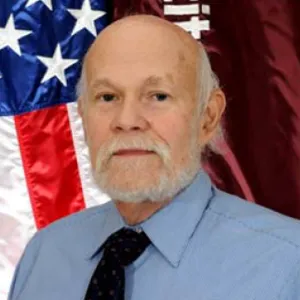
Dr. Dubick devoted his life’s work to the care of combat wounded. He served at the Letterman Army Institute of Research in San Francisco from 1988 to 1993 and then moved to the ISR in San Antonio, where he led combat casualty care research programs for 27 years. In his 32 years of service as a U.S. Army civilian scientist, he published over 300 papers and contributed significantly to the revolution in trauma care spearheaded by the U.S. military over the last two decades. He was a contributor to the development of Combat Gauze, the CAT tourniquet, the SAM junctional tourniquet, the concept of Damage Control Resuscitation and the re-introduction of whole blood to trauma care, among many other efforts. He was truly a giant in the field of military medicine.
While his achievements are unquestionably important, those whose lives he touched will remember him as a kind, thoughtful, and humble person. He was always approachable and made time to listen. He was a devoted mentor and helpful collaborator. He had a great sense of humor and was a fun travel companion. He contributed significantly to several scientific associations including the Shock Society, SCCM and THOR.
Dr. Steven Lewis Wald, age 73, passed away while at rest on Tuesday, January 12, 2021. He was born on June 2nd, 1947 in Lincoln, NE to Henry and Margaret (Gretl) Wald. He lived in Gainesville, FL at the time of his passing.
Dr. Wald grew up in Lincoln, NE and married Linda Susan Semmler while studying to become a surgeon at the University of Nebraska Medical Center. After graduating, he began his career at the University of Cincinnati hospitals where he advanced to Chief Resident in Neurosurgery in 1980. He and Linda celebrated the birth of their two children (Sarah Schoen and Aaron David) in Cincinnati in 1978 and 1975, respectively. The family then relocated to Shelburne, VT where Dr. Wald continued his career as a neurosurgeon and professor at the University of Vermont and retired there at a relatively young age in 2001. He later described his early retirement as “the smartest thing I ever did” in hindsight, considering the passing of the love of his life, Linda, in 2006.
Dr. Wald was a loving husband and father and along with his surgical prowess, was praised for his bedside manner with his patients. He had a way about him that allowed him to raise the spirits of his patients and their families in the worst of situations. He worked tirelessly to help the children of Vermont and New England live normal lives despite their neurological maladies. Spending any time in public with Dr. Wald in Chittenden County, even years after he retired, meant frequent stops to receive appreciation and gratitude from his former patients and their families.
In his retirement, Dr. Wald enjoyed improving his golf game, both in Vermont and in Palm Desert, California where he relocated in 2008. He regularly scored in the low 80s and high 70s relished the opportunity to keep score for several tour professionals during tournaments held at his home course in addition to scoring several holes in one.
Dr. Wald is survived by his daughter Sarah, his son Aaron, his brother Kenneth and sister in law Robin. He had three grandchildren: Lina Wald and Henry and Eloise Clark.
Services for Dr. Wald will be held Sunday January 17, 2021 at 1:00 PM via Zoom.
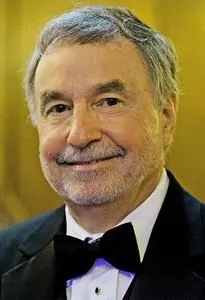
He was recruited to Omaha in 1993 to develop a hospital trauma system; the first of its kind. His expertise in trauma care built an enhanced model for the emergency medical response systems in place today.
Over the last 20 years, he served as the Medical Director for the Omaha Fire Department, Douglas County 911, Metro Community College and Eppley Airfield. He has also served as Director of Trauma for the State of Nebraska.
Dr. Stothert attended MacMurray College in Jacksonville, Illinois where he received a Bachelor of Science in Chemistry. He earned a medical degree at Saint Louis University and a doctorate in pulmonary physiology and biophysics at the University of Washington in Seattle. Dr. Stothert practiced at Saint Louis University Hospital, UTMB in Galveston, Texas, Creighton University and the University of Nebraska Medical Center. He specialized in trauma surgery and critical care.
Dr. Stothert is survived by his wife, Omaha Mayor Jean Stothert; children, Dr. Andrew Stothert (Alana) and Elizabeth Leddy (Tom); and four grandchildren.
Dr. Stothert was a member of the Western Trauma Association since 1992.
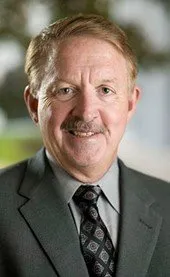
Dr. Edney was President the WTA in 2002 when the Association met at Whistler-Blackcomb. Dr. Edney also served as president of the Southwestern Surgical Congress in 2002. He was a member on the Commission on Cancer of the American College of Surgeons. Among his numerous awards is a Golden Apple Teaching Award he received from UNMC surgery resident physicians.
We will remember Jim as a clinician and educator. More importantly, he was dedicated to his family and embodied the ideals of the WTA friends and family community. He had the unique ability to make someone feel good about themselves because he was always so happy to see you. He served as a mentor to many of us that followed after him and we will miss his big laugh and smile.
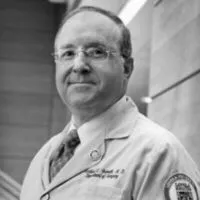
Richard was regarded as a leader and innovator in the field of burn care and was a past president of the American Burn Association (ABA) and The International Society for Burn Injury. He was a member of the American College of Surgeons, the American Surgical, The Royal College of Surgeons (Scotland), Editor-in-chief of the Journal of Burn Care & Research, member of the board of directors for the American Board of Surgery as well as a former Trustee of the University of Vermont. He received several accolades over the years including The Harvey Stuart Allen Distinguished Service Award from the ABA, (2010), the prestigious Stritch Medal (2013, Loyola), the President’s Leadership Award from the American Burn Association (2013), as well as the inaugural Catamount Surgeon award (2017, UVM), and St. Michael’s College Alumnus of the Year (2020).
Richard was extremely committed to his patients, staff, and colleagues as well as his three daughters and wife. Regardless of a weekend day or holiday, Richard visited his patients each day before returning home to enjoy one of his favorite pastimes of working in his yard, improving his home, spending time with his treasured family, or reading a great book. Richard traveled extensively during his career and visited 6 of the 7 continents and spent many years skiing the mountains of New England and the West. Over an illustrious forty-year career, Richard mentored thousands of medical students and residents and this was one of his most enjoyable roles in the world of medical academia. His years of research, patient care, teaching, administrative roles, and leadership culminated in his retirement in 2014 and subsequent move to his mountain view home built in New London, New Hampshire.
Richard’s family includes Mary, his wife of 49 years, his daughters Amy Gamelli (Steven Schweitzer), Andrea Couture (Denis), Liza Gamelli (Fiancé Erich), and three grandchildren- Jacob, Hannah, and Henry Couture. His presence will be missed by so many friends and family. He truly was a leader and a “maverick” in his life and career. He inspired so many to work harder, strive for better, and give the best of themselves. He believed in people before they believed in themselves and his legacy will live on in all those that were touched by his life and career. The family would like to recognize and thank Richard’s exemplary caregivers that treated him with compassion and love and because of their care, he was able to remain in his home for the course of his disease.
A celebration of life will be planned for later this year in New Hampshire. In lieu of flowers, donations can be made to the Illinois Fire Safety Alliance in support of the children’s burn summer camp “I AM ME” in memory of Dr. Richard L. Gamelli. 426 West NW Highway Mount Prospect, IL 60056 in c/o Jenny Tzortzos.
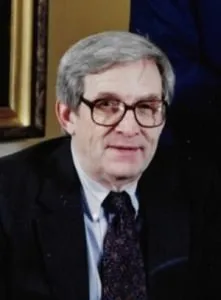
Rudi was an early member of the WTA. Founding President Bob Volz, MD remembers:
I first met Rudi when he was a guest at the second WTA meeting in Vail 1972. In the ensuing years, I came to regard Rudi and his wife Frieda as the most accomplished skiers in the WTA. Both seemed to glide from mogul to mogul with such grace. Consequently, a small group of skiing friends with similar leanings bonded together thus creating a select and challenging fellowship to be seen schussing down the mountain. Beyond remarkable skiing talent, Rudi represented himself as a nationally recognized staff member of the Mayo Clinic, always presenting as a reserved and well-informed educator. Together Rudi and Freida were as a couple friendly, welcoming faces most representative of the WTA to fellow and new members.
1993 President David Feliciano, MD adds:
Dr. Klassen was a senior orthopedic surgeon at the Mayo Clinic who was an early supporter of the WTA. He, Ron Linschied, and, later, Peter Mucha and I, were part of the Mayo “mafia” who were regular attendees at early meetings. Rudi was very quiet and rarely discussed papers, but had many friends among the founders.
Rudi was described as an avid outdoorsman and skier, which made his involvement in the WTA a natural fit, particularly in the early era when orthopedic papers were a major part of each program. He selected Sun Valley, ID for his 1986 meeting, which was the second time the group met there. Sun Valley 1986 was my first WTA meeting, where I presented a small paper sponsored by and written with Barry Esrig, MD. As a starry-eyed fourth-year resident in general surgery, I was impressed with the eminent surgeons in this organization, and particularly with Dr. Klassen’s friendly and gentle manner as he presided over the meeting.
Mark Metzdorff
Read Dr. Klassen’s full obituary at alumniassociation.mayo.edu/obituaries/rudolph-klassen-m-d-or-69/.
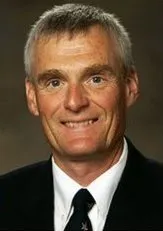
Tom was born on December 12, 1952, in Pittsfield, MA. He attended Dartmouth College and went on to attend the University of Colorado School of Medicine, graduating in 1977. Tom was a resident in General Surgery at the University of Colorado from 1977-82. There, thanks largely to his mentor and lifelong friend Gene Moore (WTA President 1989), he became acquainted with the Western Trauma Association, at a time when the organization was evolving from a relatively informal regional gathering to the nationally known resource we recognize today. He attended his first meeting in 1982, where he presented a paper on pancreatic trauma.
His contributions to the WTA were many and significant. From his beginning with the organization and well into the past decade, he presented, coauthored, or sponsored numerous clinical research papers. Perhaps most significantly, he organized and presented the first WTA multi-institutional trial, on hepatic trauma, in 1988. Over the next six years he led, presented, and published four more WTA multicenter trials on a diverse group of trauma topics; the 1989 paper on non-operative management of splenic injuries was sentinel in changing the management of this entity. Of the 50 WTA multicenter trial papers published to date, Tom was the first author on five and coauthor on at least five more. Because of his enthusiasm for the concept, he was “awarded” the privilege of founding and chairing the ad hoc WTA Multicenter Trials Committee, which he shepherded for 13 years. In 2003 the committee was given Bylaws status as a standing committee of the WTA and continues to produce significant studies annually, eagerly anticipated at each meeting.
He served on other important WTA committees, on the WTA Board of Directors, and ascended to the WTA Presidency for 1995-6. His year in office culminated in his presiding over one of the most classic WTA meetings ever, held at Tom’s favorite ski area: Grand Targhee, Wyoming It occurred at a time when the WTA was still a small, much more informal organization. Anyone who attended that meeting could attest to the challenges posed by the (then) small resort’s limited facilities, its small and spartan rooms, and its standing-room-only meeting room. And yet, in typical WTA fashion, a wonderful meeting was had, with all the hallmarks of the WTA: great science, family fun, collegiality and the world-class winter sports opportunities of a unique venue with great downhill and Nordic skiing. Tom’s Presidential Address was a typically cogent analysis of the elements of a successful and rewarding career in trauma surgery, particularly through the lens of his experience as a rural, private-practice, nominally non-academic practitioner. It is worth a read (click to read) and remains relevant 26 years later. In later years, he continued to contribute as an active participant in the Past Presidents Committee, and as an editor and author of two chapters in the WTA’s 50th Anniversary history book.
Tom Cogbill provided an impeccable example of a student, teacher, researcher, scientist, mentor, and leader. He was a major contributor to the development and growth of the WTA from the beginning of his involvement until the end. He was a model husband and father, and a friend to all who knew him. While he will be profoundly missed, his many contributions will ensure that he will be forever remembered in the annals of the Western Trauma Association.
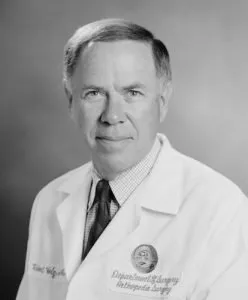
Raised in Lincoln, Nebraska, Dr. Volz discovered a love of science at an early age. This passion was matched only by his love of the outdoors and the mountainous west. As such, he began climbing mountains at the age of 13, and eventually went on to climb nearly all 58 of the 14,000-foot peaks in Colorado. He later in life led five trips to Nepal, climbing to the base camp of Mt. Everest twice.
Following his adolescence in Lincoln, Dr. Volz began undergraduate studies at Westminster College in Fulton, MO, and received his bachelor’s degree from the University of Nebraska in 1954. He went on to graduate from the University of Nebraska College of Medicine in 1957 and completed orthopedic specialty training at the University of Kansas Medical Center.
Dr. Volz and his wife, Ann, then moved to Denver, where he practiced at Presbyterian Medical Center and served as head of the orthopedic department at Denver Children’s Hospital. While living in Denver, he co-founded the Western Trauma Association (WTA), an academic society devoted to advancing the care of trauma-injured patients, now one of two internationally respected professional trauma societies.
In 1973, Dr. Volz was recruited to the University of Arizona Medical Center (UAMC) to build a total joint surgery program in the newly-founded Department of Orthopedics, where he served as chief from 1985 until his retirement in 1992. His greatest joy during his tenure at UAMC was national recognition of UAMC’s Orthopedic Residency Program and the privilege to assist in the training of many bright, young, talented doctors. Driven by innovation, he established a novel biomechanics research laboratory – now known as the Robert G. Volz, MD, Orthopedic Research Laboratory – devoted to the design and testing of new total joints.
A scientific visionary, Dr. Volz designed the first wrist prosthesis in the United States – an accomplishment recognized by the American Hospital Association as one of the country’s ten major medical advances in 1974. He later designed a total elbow prosthesis and an artificial knee that was widely used in the U.S. and beyond.
Recognizing the need for a collaborative approach to caring for patients, Dr. Volz went on to help create a unique environment in which orthopedic residents and rheumatology fellows cared for patients in the same clinic. This patient-centered model informed and inspired many budding orthopedic surgeons and rheumatologists who were part of the program that led to the creation of the University of Arizona Arthritis Center (UAAC); one of the first of four Centers of Excellence in the University of Arizona College of Medicine. With his continued commitment as a founder and Advisory Board chair, the UAAC has grown to be a multidisciplinary hub of patient care, research, education and innovation.
Upon his retirement in 1992, he and Ann devoted time to medical outreach and patient care in many third-world countries. As part of his dedication to humanitarian efforts, he went on to perform surgeries in more than a dozen foreign countries.
His continued commitment to the underserved also led him to focus efforts on the needs of the medically uninsured in the U. S. While living part-time in Jackson Hole, Wyoming, he sponsored a state bill which provided for the creation of ‘Free Outpatient Allied Health Clinics’ – allowing retired physicians to offer free healthcare services. Subsequently, he was appointed to the Governor’s Healthcare Commission.
Honored by the University of Arizona as professor emeritus and recognized as one of its top innovators of the past 100 years, Dr. Volz continues to be remembered nationally and internationally for his many contributions to the field of medicine. Combined with the care he provided to patients and the knowledge he imparted on trainees, these contributions have helped relieve suffering and improve the quality of life for countless patients worldwide.
Dr. Volz is survived by Ann, his wife of 66 years; children Kathryn Clark, Thomas Volz, Amy Jobst, and Jack Volz (Sara); grandchildren Katie, Graham and Peter Clark, Derek and Ellie Jobst, Ashleigh Volz and Emily Volz.
A memorial service will be held on Friday, January 12, at 11:00 a.m., at St. Philips in the Hills Episcopal Church. In lieu of flowers, donations in memory of Dr. Volz may be made to the University of Arizona Arthritis Center (https://give.uafoundation.org/arthritiscenter) or St. Philips in the Hills Episcopal Church (https://stphilipstucson.org/how-do-i-give).
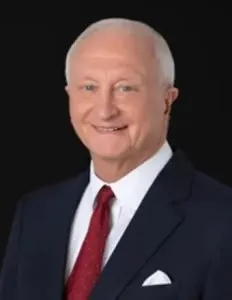
Born in New York City, New York, he was the son of the late Dr. Vincent and Anita (Hessler) Feliciano. David was a graduate of Hawthorne High School, received his undergraduate and medical degrees (cum laude) from Georgetown University and his training in general surgery at the Mayo Clinic. He also had training in trauma at Detroit Receiving Hospital/Wayne State University, and in vascular surgery (6 month Fellowship) at Baylor College of Medicine. Dr. Feliciano was a Lieutenant in the U.S. Navy Medical Corps Reserve (Port Hueneme, California). He was Surgeon-in-Chief at Grady Memorial Hospital and a Professor of Surgery at Emory University in Atlanta from 1992-2011 and then was Chief of General Surgery at Indiana University and Chief of Surgery at Indiana University Hospital from 2013-2017. In 2018, he became a Clinical Professor of Surgery at the University of Maryland and an Attending Surgeon (recently emeritus) at the Shock Trauma Center/Department of Surgery.
A pioneer in trauma surgery, Dr. Feliciano became world renowned in vascular trauma and emergency general surgery. He published almost 700 articles/chapters/books and served on numerous prestigious Editorial Boards including having served as an Associate Editor of The American Surgeon. He has been Co-Editor of the textbook TRAUMA through all nine editions and was lead Co-Editor for the 3rd, 6th, and 9th editions.
Dr. Feliciano was a member of 25 surgical or medical organizations including the American Surgical Association, Southern Surgical Association, and the American Association for the Surgery of Trauma. He was President of the Priestley Society (Mayo Surgeons), 1991-1992; President of the Southwestern Surgical Congress, 1991-1992; President of the Western Trauma Association, 1992-1993; President of the Panamerican Trauma Society, 1999-2000; President of the Atlanta Surgical Association, 2004-2005; President of the American Association for the Surgery of Trauma, 2006-2007; President of the Georgia Surgical Society, 2009-2010; President of the Southeastern Surgical Congress, 2016-2017; was Chair of the Advisory Council for General Surgery, American College of Surgeons, 2007-2011; and was a Director, American Board of Surgery, 2001-2007. Besides being a gifted and dedicated surgeon, one of his greatest legacies was his 49 Teaching Awards which deemed him a master educator. In 2016, he received the Distinguished Alumnus Award from the Mayo Clinic and, in 2021, he received a Distinguished Service Award from the Southeastern Surgical Congress.
He and his wife, Grace loved living on the water and enjoyed boating and kayaking on the Chesapeake. They were members of the Holy Family Catholic Church in Davidsonville, Maryland. He was a man of the highest character and deep faith who, as a beloved surgeon, teacher, mentor, and father will be missed by many.
Dr. Feliciano was preceded in death by his parents and brother, Donald. Surviving are his wife of 22 years, Grace (Grace F. Rozycki, MD); his greatest legacy his two sons, (David Feliciano in Houston, Texas and Douglas Feliciano, JD in Mountain View, California), sister (Joan DeFreest, Hewitt, New Jersey), his former spouse, Barbara Feliciano (Waimea, Hawaii) several nieces, nephews, and cousins.
The family wishes to thank Dr. Thomas Scalea, Physician-in Chief, R Adams Cowley Shock Trauma Center; System Chief for Critical Care Services, University of Maryland Medical System along with his superb team for the extraordinary care provided to Dr. Feliciano over several years.
A viewing will be held on Tuesday, January 9th from 4pm to 8pm at Browning-Forshay Funeral Home in Hawthorne, New Jersey. A Mass of Christian burial will be held at Saint Anthony’s Roman Catholic Church in Hawthorne, New Jersey on Wednesday, January 10th at 11am. Interment will be on Friday, January 12th at 1pm at Laurel Grove Cemetery in Totowa, New Jersey.
In lieu of flowers, please consider making a donation to the David V. Feliciano, MD Fellowship Fund. Checks should be payable to the UMB Foundation with the David Feliciano Fellowship Fund on the memo line. They should be sent to Dr. Thomas Scalea’s Office, R Adams Cowley Shock Trauma Center, 22 S Greene St, Baltimore, MD, 21201.

